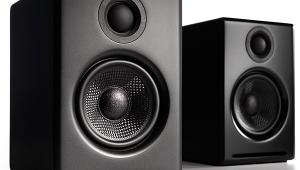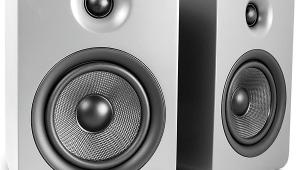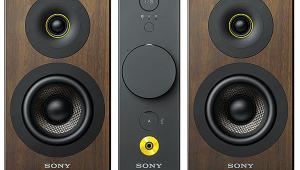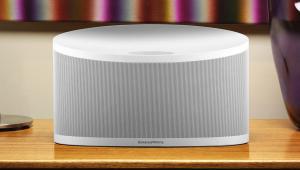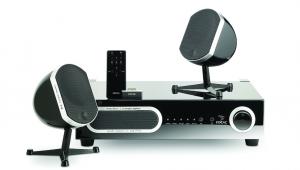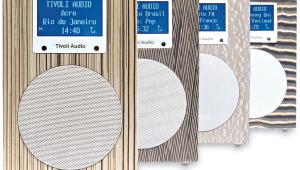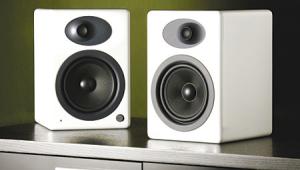Polk Audio I-Sonic
I was smitten with Polk's I-Sonic tabletop system when I first laid eyes (but no hands-this was a prototype) on it at a Polk press conference. The strong fixation, no doubt, grew out of my need to replace an aging Bose Wave radio that had served me well but was clearly at its watts' end. I was also enticed by the unusually swanky set of features (a built-in DVD player, XM capability, and HD Radio). And then, of course, there was the fact that I couldn't get my hands on one; exclusivity is often enticing.
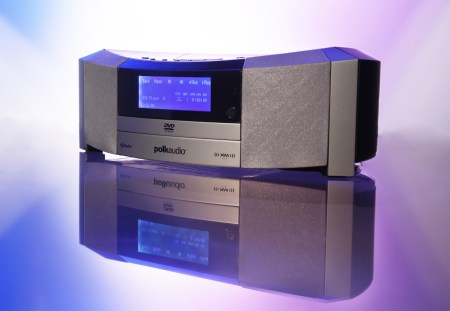
Polk's masterful minister of propaganda, Paul DiComo, assured me time after time, month after month, quarter after quarter, that the I-Sonic was, indeed, a real product that would be out "any day now." The engineers simply needed a little extra time to make sure they had perfected the new Polk product.
After the long wait, I finally have an I-Sonic in the pink (well, gray) to fiddle with, and I see that Polk's Paul wasn't playing with me after all. The extra time was worth the wait.
Overclocking the Clock Radio
It's probably unhealthy to have been so enamored of what some might, at first glance, assume is essentially a souped-up, overclocked clock radio. But equating the I-Sonic in any way to a standard clock radio is like equating cashmere to polyester.
So, if it's not a clock radio, what the heck is an I-Sonic? Sure, it has a clock, two separate alarms, and a radio, so it definitely qualifies as a clock radio. But, in addition to standard AM and FM reception, the I-Sonic is one of the first home audio components capable of tuning in (free, if you don't count the commercials) HD Radio signals. With an optional (not-free) mini-tuner cartridge, the I-Sonic can also receive XM Satellite Radio (not-free) channels. Since man can't live by radio (analog or digital) alone, Polk packs a CD/DVD player in the I-Sonic, too, as well as two auxiliary audio inputs.
The Polk folks say the I-Sonic is the first "all-digital-format entertainment system" to bring together the features I've mentioned so far in a single, compact tabletop configuration that's also a high-performance audio system. (That's easy for them to say, but I take issue with the word "all" when DVD-Audio and SACD playback are absent.)
Bass, Bass, Baby
It's no stretch to see how cool it is to have both analog and digital radio sources plus a CD/DVD player in the same unit, but the terms "high performance" and "compact tabletop entertainment system" don't come together easily in my mind. As it turns out, the thing that most sets the I-Sonic apart from the rest of the very crowded compact tabletop-/bookshelf-system pack is the high quality of its audio performance.
Now, let's be real. There's no way an audio system that's about half the size of a compact microwave oven will be able to compete with a full-blown home theater system-or a serious, multi-component, two-channel system, either. But what the I-Sonic does do exceptionally well is use a minimum of physical space to produce a maximum of perceived acoustical listening space.
The I-Sonic uses Polk's PowerPort bass-venting technology, a design concept that aims at reducing turbulence at the speaker's port. The result is supposed to be lower distortion and improved efficiency, but, whatever it does, it definitely works in the I-Sonic. While it won't rattle the rafters, the I-Sonic's bass output is excellent for music and serious enough that you can hook up the built-in DVD player to a bedroom TV and watch a bass-filled movie, like Monster House, without shame. (But you will shudder.)
Two Speakers Aren't Good Enough for You, Eh?
If you ask the people at Polk why the I-Sonic doesn't have a simulated surround sound setting, they'll tell you to blow it out your backside-literally. In addition to the two full-range speakers firing forward, the I-Sonic includes a pair of rear-firing speakers. It's this bright bit of engineering that makes for the I-Sonic's most impressive aspect: its ability to generate a stereo soundfield both in front of and behind the unit itself.
From the front, the I-Sonic's soundfield is wide-much wider than what you'd hear with most similarly sized units. With a wall behind the system, the big, broad soundfield is very reminiscent of a pair of bipolar speakers' sound characteristics. With the I-Sonic in a more open area, though, the little wonder creates a circle of stereo sound around itself. It sounds hard to believe, and it's hard to believe the way it sounds. Walking around the I-Sonic, you will hear stereo. It isn't absolutely perfect at all locations, and it doesn't always have that nice, wide bipolar character. But the effect is amazing, and it means that the I-Sonic could work as a sound system for more than one listening area.
The I-Sonic also plays surprisingly loud without distortion or harshness, which Polk says is the result of built-in Digital Signal Processing (DSP) that includes both Dynamic Loudness Contour (which adjusts bass and treble depending on the volume level) and Dynamic Compression (which prevents audible distortion at high volumes) circuitry. Speaking of bass and treble, the I-Sonic is one of the few compact systems that sports separate bass and treble controls.
There's Radio, and Then There's Digital Radio
The I-Sonic includes a standard AM/FM tuner (yawn), but the digital stuff is where the excitement is. First is XM Satellite Radio. Because an XM tuner isn't included in the I-Sonic, you'll have to spend around $60 to add an XM mini-tuner cartridge and home dock, which is essentially an XM antenna with a removable tuner cartridge installed. The nice thing about the tuner cartridge is that you can use it in other tuner-cartridge-based XM devices, so you don't have to pay for multiple subscriptions.

HD Radio is a digital radio format that you don't have to pay cash to listen to, and the only antenna you'll generally need is the plain old FM dipole that's included in the I-Sonic's box. HD (Hybrid Digital) Radio, in case you haven't heard of it, allows radio stations to simulcast one or more digital channels of music, talk, or data within roughly the same frequency band as the station's analog transmission.
The claimed benefit of HD Radio is improved sound quality. The HD Radio folks like to say it makes FM sound like CD and AM sound as good as standard FM, but that may be overenthusiastic. The technology should be capable of a noticeable improvement in frequency response and dynamic range, if the station chooses to allocate their bandwidth as such. The lack of static and multipath interference that plagues analog radio is also a huge plus.
HD Radio on the I-Sonic definitely sounds great (FM HD Radio is almost CD quality), but there's no way to tell the I-Sonic to turn off HD Radio tuning. If you live in a fringe reception area for a particular station, the signal can often drop in and out of digital. Most of the time, it's a mild inconvenience, much like when an analog tuner switches in and out of stereo. But, depending on how good the station is at implementing the technology, there may be a difference in volume or, worse, an audible delay between the analog and digital signals. These are more broadcaster issues than a fault of the I-Sonic, though. Hopefully, these issues will be ironed out over time
What's Not to Like?
Overall, the I-Sonic is one great little system, and it was well worth the wait. But there are a few things I don't like about it. One is the paltry, credit-card-size remote control. I'm sure there are a lot of focus-group participants out there who like small, inconspicuous remotes, but I'm not one of them. I'd also like the system to turn on when I press one of the input buttons rather than having to push Power and then an input button. The menu system is a little clunky to use, and it would be easier to navigate if the remote control had a Back button on it. Being able to access all functions and menus from the unit itself deserves an "A+" rating, though. I'd also like the I-Sonic to have a Blu-ray or HD DVD player in it instead of the CD/DVD player. (OK, now I'm just dreaming.)
If the I-Sonic were nothing more than a dressed-up clock-radio pig in a Polk, the $599 price would be outrageous. As it turns out, it's darn near impossible to find another tabletop system (with or without a built-in clock) that performs as well, has such flexibility in placement, or can sound satisfying in such a broad range of listening positions. For me, it was certainly worth the wait, and it's absolutely worth the sticker price. In fact, I think this is a radio even Paul Harvey could love.
Highlights:
• XM and HD Radio
• 360-degree stereo sound
